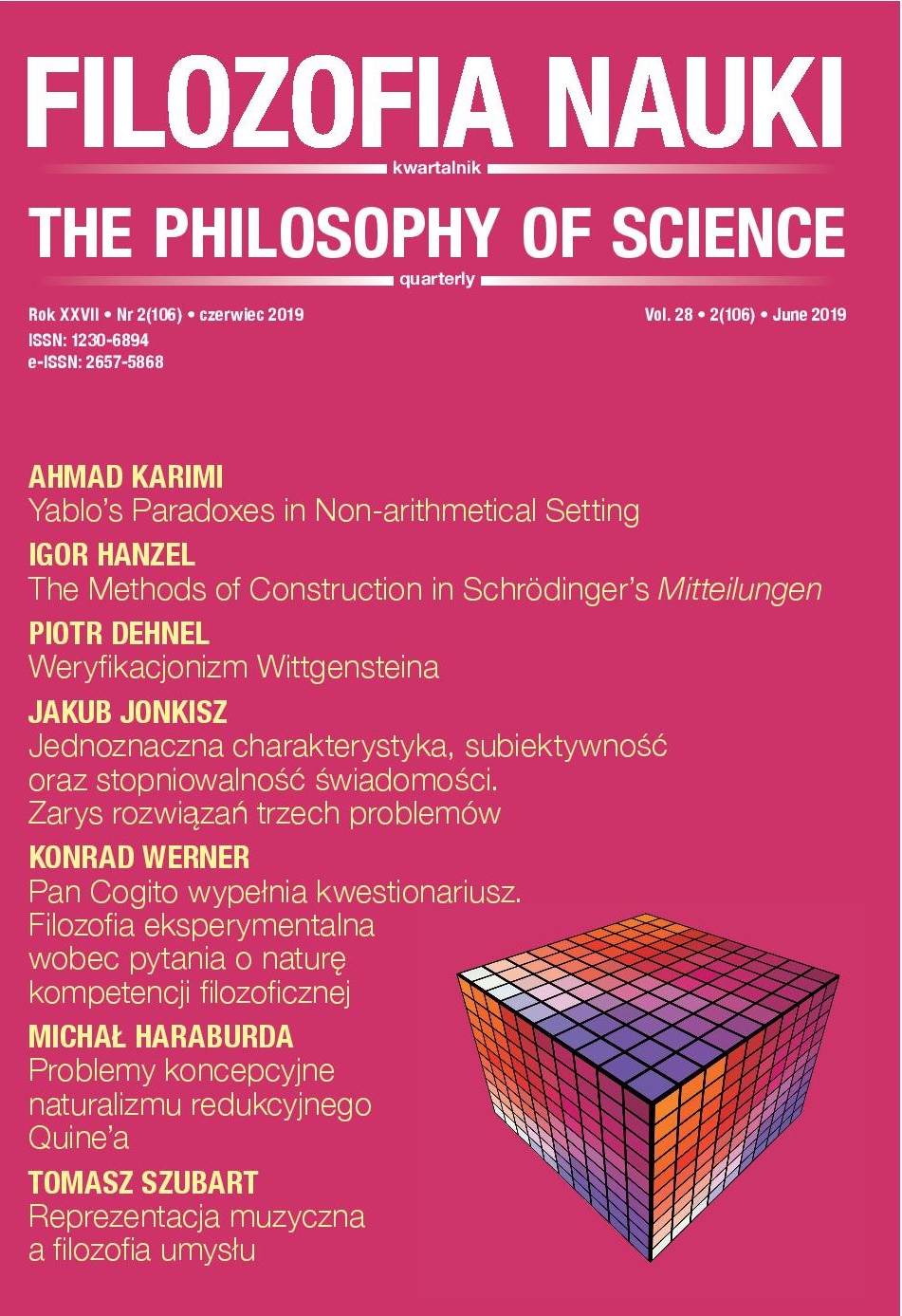Reprezentacja muzyczna a filozofia umysłu
DOI:
https://doi.org/10.14394/filnau.2019.0014Słowa kluczowe:
muzyka, reprezentacja, znacznieAbstrakt
Representation is one of the key concepts in cognitive science and philosophy of mind. The philosophical problem of musical meaning, or rather its naturalistic reformulation, has only recently become the topic of empirical investigation. It might seem obvious that an explication of the concept of meaning would appeal to the concept of representation. It is not a popular approach in the philosophy of the cognitive science of music, however. The aim of this paper is to provide an overview of possible frames of analysis of musical representation within selected contemporary paradigms in the broadly understood philosophy of mind and cognitive science.
Bibliografia
Clark A. (2001), Mindware, New York—Oxford: Oxford University Press.
Cook D. (1959), The Language of Music, Oxford: Oxford University Press.
Cross I. (2009), The Evolutionary Nature of Musical Meaning, „Musicae Scientiae” 13(2), 179-200. https://doi.org/10.1177/1029864909013002091
Davies S. (1993), Representation in Music, „Journal of Aesthetic Education” 27(1): 16-22. https://doi.org/10.2307/3333337
Davies S. (1994), Musical Meaning and Expression, Ithaca, NY: Cornell University Press.
Feldmann Barrett L. (2006), Are Emotions Natural Kinds?, „Perspectives on Psychological Science” 1(1), 28-58. https://doi.org/10.1111/j.1745-6916.2006.00003.x
Fritz T., Jentschke S., Gosselin N., Sammler D., Peretz I., Turner R., Friederici A. D., Koelsch S. (2009), Universal Recognition of Three Basic Emotions in Music, „Current Biology” 19(7), 573-576. https://doi.org/10.1016/j.cub.2009.02.058
Fubini E. (2002), Historia estetyki muzycznej, Kraków: Musica Jagiellonica.
Gabrielsson A. (2001), Emotion Perceived and Emotion Felt: Same or Different?, „Musicae Scientiae” [Special issue 2001-2002], 123-147. https://doi.org/10.1177/10298649020050S105
Gabrielsson A., Lindström E. (2001), The Influence of Musical Structure on Emotional Expression [w:] Music and Emotion: Theory and Research, P. N. Juslin, J. A. Sloboda (eds.), London: Oxford University Press, 223-248.
Guczalski K. (2002), Znaczenie muzyki znaczenia w muzyce. Próba ogólnej teorii na tle estetyki Susanne Langer, Kraków: Musica Jagiellonica.
Hanslick E. (1903), O pięknie w muzyce. Studjum Estetyczne, Warszawa: M. Arct.
Hensel W. M. (2017), Załóżmy, że nie jest najprościej. Polemika z Pawłem Gładziejewskim na temat psychologii potocznej, „Filozofia Nauki” 25(3) [99], 81-99.
Hill T. W. (2014), Affective Responses to Music Without Recognition: Beyond the Cognitivist Hypothesis, „The New School Psychology Bulletin” 11(1), 42-49.
Huron D. (2006), Sweet Anticipation. Music and the Psychology of Expectation, Cambridge: Cambridge University Press.
Jabłoński M. (1999), Muzyka jako znak. Wokół semiotyki muzyki Eero Tarastiego, Poznań: PTPN.
Katz J., Pesetsky D. (2011), The Identity Thesis for Language and Music. https://ling.auf.net/lingbuzz/000959
Kirchhoff M. (2011), Anti-representationalism: Not a Well-founded Theory of Cognition, „Res Cogitans” 2, 1-34.
Kivy P. (1980), The Corded Shell Reflections on Musical Expression, Princeton: Princeton University Press.
Koelsch S. (2004), Music, Language and Meaning: Brain Signatures of Semantic Processing, „Nature Neuroscience” 7(3), 302-307. https://doi.org/10.1038/nn1197
Koelsch S. (2012), Brain and Music, Oxford: Wiley-Blackwell.
Konečni V. J. (2008), Does Music Induce Emotion? A Theoretical and Methodological Analysis, „Psychology of Aesthetics, Creativity, and the Arts” 2(2), 115-129. http://doi.org/10.1037/1931-3896.2.2.115
Langer S. (1979), Philosophy in a New Key: A Study in the Symbolism of Reason, Rite, and Art, Cambridge, MA: Harvard University Press.
Millikan R. G. (1995), Pushmi-pullyu Representations, „Philosophical Perspectives” 9, 185-200. http://doi.org/10.2307/2214217
Miłkowski M., Poczobut R. (2012), Przewodnik po filozofii umysłu, Kraków: WAM.
Nattiez J. (1990), Music and Discourse: Toward a Semiology of Music, Princeton: Princeton University Press.
Nussbaum C. (2007), The Musical Representation. Meaning, Ontology, and Emotion, Cambridge: MIT Press.
Patel A. (2008), Music, Language, and the Brain, New York: Oxford University Press.
Podlipniak P. (2017), Tonal Qualia and the Evolution of Music, „Avant” 8(1), 33-44. http://dx.doi.org/10.26913/80102017.0101.0002
Scruton R. (1976), Representation in Music, „Philosophy” 51(197), 273-287. http://doi.org/10.1017/S0031819100019331
Skrzypulec B. (2015), Relational Construction of Visual Objects, „Filozofia Nauki” 23(2)[90], 45-68.
Zangwill N. (2004), Against Emotion: Hanslick Was Right about Music, „British Journal of Aesthetics”, 44(1), 29-43. https://doi.org/10.1093/bjaesthetics/44.1.29
Żegleń U. (2012), Treść i reprezentacje umysłowe [w:] Przewodnik po filozofii umysłu, M. Miłkowski, R. Poczobut (red.), Kraków: WAM, 213-252.



















 Filozofia Nauki | ISSN 1230-6894 | e-ISSN 2657-5868
Filozofia Nauki | ISSN 1230-6894 | e-ISSN 2657-5868